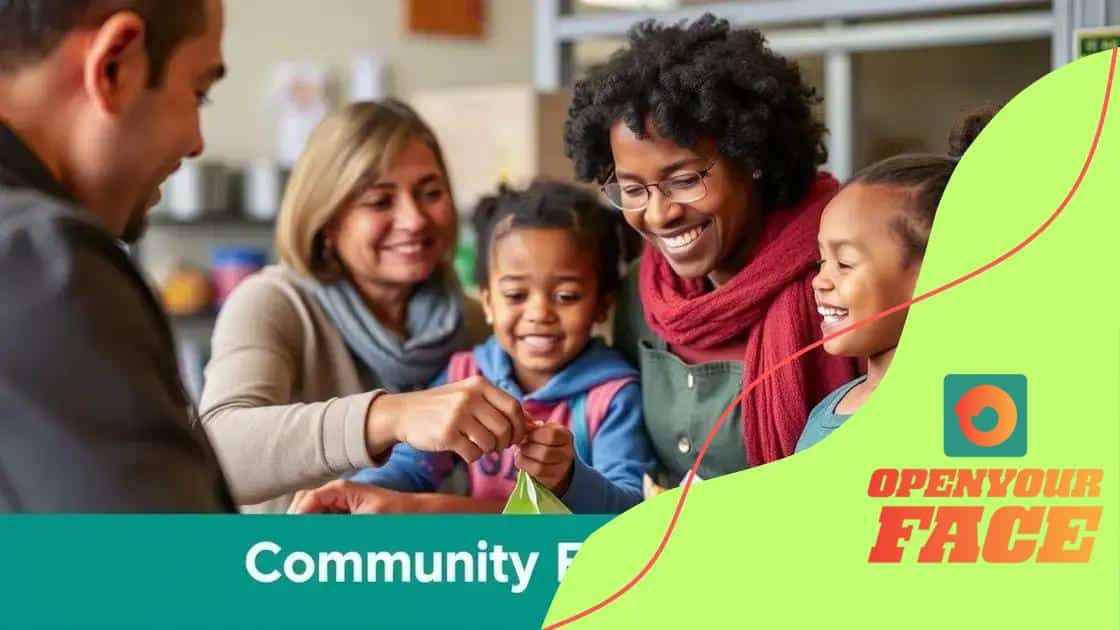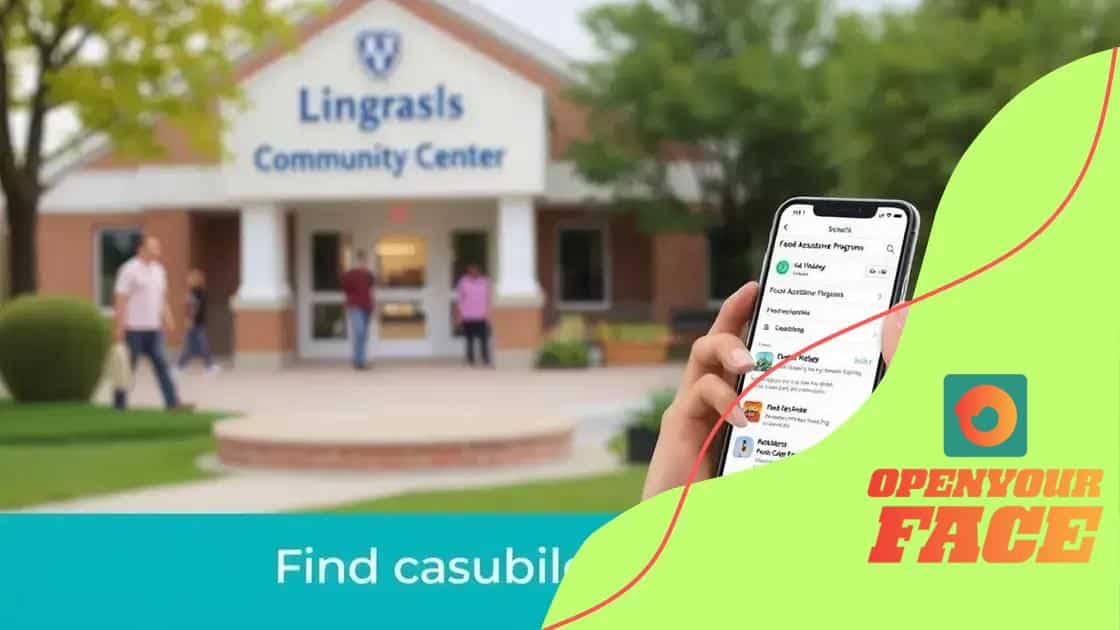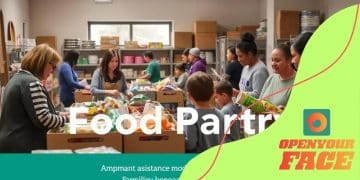How to get emergency food assistance during tough times

To get emergency food assistance during tough times, locate local food banks, soup kitchens, or government aid programs, ensuring you have necessary documentation like ID and proof of income ready.
How to get emergency food assistance during tough times is a question many may face unexpectedly. The process can feel overwhelming, but knowing where to turn can make a significant difference when you’re in need.
Understanding emergency food assistance
Understanding emergency food assistance is crucial for anyone facing tough times. This type of support can provide essential resources to individuals and families in need when food insecurity strikes unexpectedly.
Emergency food assistance programs are designed to help those who need immediate help. Many organizations work tirelessly to ensure that groceries and meals are accessible to everyone. Knowing how these programs operate can empower you to seek help when necessary.
Types of Emergency Food Assistance
There are several types of food assistance available:
- Food banks, which distribute food to individuals and families.
- Soup kitchens, where meals are served directly to those in need.
- Food pantries, which allow recipients to select their food.
- Government assistance programs, including SNAP, that provide financial aid for purchasing groceries.
Each of these resources plays a vital role in the community, and knowing where to find them can be a lifeline. It’s important to recognize that seeking assistance is a brave step, and you are not alone in this situation.
In addition to immediate food aid, many programs also offer additional resources. Some organizations provide nutritional education, job training, or financial counseling. These services can be incredibly beneficial for those looking to improve their overall circumstances beyond emergency assistance.
How to Access Food Assistance
Getting help from these programs can seem overwhelming, but it doesn’t have to be. Here are a few steps to guide you:
- Research local food banks or emergency service programs.
- Contact them to understand their hours and requirements.
- Gather any necessary documentation, like ID or proof of residency.
- Be prepared to explain your situation, which can help staff direct you to the right resources.
Remember, access to emergency food assistance can be a crucial step in maintaining your health and well-being during tough times. The help is out there, and it’s meant for you.
Eligibility requirements for food aid
Eligibility requirements for food aid can vary significantly depending on the program and location. Understanding these requirements is essential for those seeking assistance. Generally, organizations that provide food aid have specific guidelines to determine who qualifies to receive help.
Many food assistance programs require applicants to meet certain income limits. These limits are often based on the federal poverty level and can change yearly. By checking these income guidelines, individuals can quickly assess their eligibility.
Common Criteria for Food Assistance
Eligibility is usually determined based on a few key factors:
- Income level in relation to the federal poverty line.
- Family size, which affects the amount of aid that can be offered.
- Residency in the area served by the food program.
- Specific demographic characteristics, such as age or disability status.
Providing proof of these factors may involve submitting documentation like pay stubs, tax returns, or identification. It’s vital to prepare these documents in advance to ensure a smooth application process.
Some programs also take into account temporary situations that cause food insecurity. For instance, job loss, medical emergencies, or unexpected expenses can affect eligibility. By explaining these situations during the application process, applicants might receive additional consideration.
Applying for Food Aid
The application process can differ based on the organization. However, many programs offer both online and in-person applications. When applying, it’s beneficial to be honest and thorough. This transparency helps organizations fully understand your needs and direct you to the right resources.
In some cases, assistance may be available even if initial eligibility requirements seem strict. Local community organizations or churches often have their criteria that might be more flexible, ensuring that no one has to go hungry amidst hardship.
How to locate nearby food assistance programs

Knowing how to locate nearby food assistance programs is essential for anyone in need. Thankfully, there are many resources available to help individuals and families find the support they require. By using a few simple methods, you can connect with organizations that provide food aid.
One of the most effective ways to begin your search is by using online tools. Websites like Feeding America and local food bank directories offer searchable databases. You simply enter your zip code, and they provide a list of food assistance programs in your area.
Utilizing Local Resources
Connecting with local community centers and religious organizations can also yield valuable information about food assistance. Many churches and community groups maintain lists of resources and may even operate their food pantries. Additionally, resources like:
- United Way, which can direct you to local support.
- Local health departments, which may offer food programs.
- School districts that may provide meals to families in need.
A phone call or visit to these organizations can provide quick answers and guidance on where to secure food assistance in your community.
If you prefer face-to-face help, visiting local food banks or government social service offices is a great option. These places often have staff who can assist you with finding food programs and complete necessary applications on-site.
Engaging with the Community
Another effective method is to engage with local community groups on social media. Many neighborhoods have Facebook groups or other platforms where residents share resources and support each other. Asking for help in these communities could lead you to programs that may not be widely advertised.
Do not hesitate to ask friends or family for recommendations as well. They may know of resources available in your area that could assist you.
Tips for approaching food assistance services
Approaching food assistance services can be daunting, especially if it’s your first time seeking help. However, there are several tips that can make the process easier and more efficient. Understanding how to navigate these services can lead to better support and resources during tough times.
One important tip is to do your research before reaching out. Knowing which services are available in your area and what they offer can save time and stress. Many organizations have websites with detailed information about their programs, eligibility, and how to apply.
Prepare for Your Visit
Before visiting a food assistance service, gather necessary documents to streamline the process:
- Identification, such as a driver’s license or ID card.
- Proof of income or financial situation, like pay stubs or tax returns.
- Any relevant bills or rental agreements that outline your expenses.
Having these documents ready can help staff better understand your situation and provide the most appropriate assistance.
When approaching the staff, be clear and honest about your needs. Share your circumstances and any specific challenges you’re facing. Staff members are trained to help and can best assist you when they have a complete picture of your situation.
Follow Up
After your initial visit or contact, remember to follow up if you do not receive a response or if you have questions. Many organizations appreciate proactive clients. Staying in touch shows commitment and ensures that your case is still being processed.
Finally, don’t hesitate to seek help from more than one source. If one program doesn’t meet your needs, there may be other local resources available. Networking within your community can uncover additional assistance programs that might provide you with more comprehensive support.
Real stories of those helped by food programs
Real stories of those helped by food programs can inspire hope and encourage others to seek assistance. These narratives highlight the difference that community support can make in people’s lives. Many individuals have faced tough times and found relief through various food assistance services.
Take, for example, the story of Maria, a single mother who lost her job during the pandemic. With bills piling up, she struggled to provide meals for her three children. After learning about a local food pantry, she decided to reach out. The pantry not only provided groceries but also connected her to job training programs, which helped her get back on her feet.
Transformed Lives
Another inspiring story is that of James, an elderly veteran. After his savings dwindled, he found it hard to afford healthy food. With the help of a senior food program, James received regular food boxes filled with fresh fruits and vegetables. This support not only filled his pantry but also improved his health and well-being.
There are countless stories just like Maria’s and James’s. Each person has a unique journey, but they all share similar themes of resilience and community support. These stories remind us that it’s okay to ask for help when needed. They encourage others to take that brave step and reach out to local services.
Building a Supportive Network
Connecting with food programs often leads to building a larger network of support. Many recipients become advocates, sharing their experiences and encouraging others to seek assistance. They volunteer at food banks, help organize community events, or simply spread awareness of available resources.
These real-life stories underscore the importance of food programs. They demonstrate that while circumstances may be difficult, assistance is available. With hope, determination, and community support, anyone can find a way to overcome their challenges.
FAQ – Questions About Emergency Food Assistance Programs
What types of food assistance programs are available?
There are various types, including food banks, soup kitchens, and government assistance programs like SNAP.
How can I find food assistance in my area?
You can search online through resources like Feeding America or local community centers for nearby programs.
What documents do I need to provide when applying for food aid?
Typically, you’ll need identification, proof of income, and residency information.
Can I receive help if I’m not currently employed?
Yes, many programs provide assistance regardless of employment status, especially during times of crisis.






